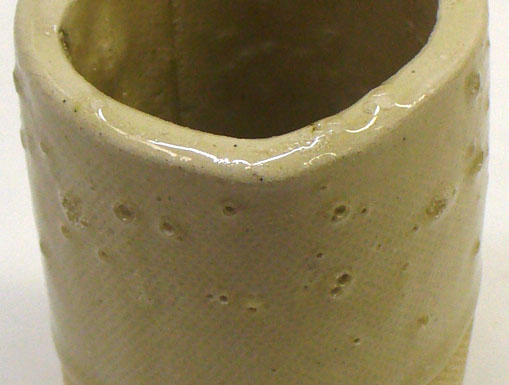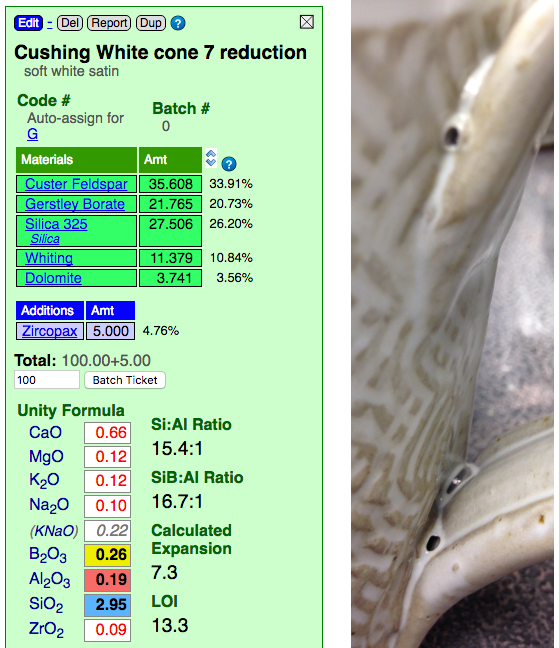| Monthly Tech-Tip | No tracking! No ads! | |
Surface Tension
In ceramics, surface tension is discussed in two contexts: The glaze melt and the glaze suspension. In both, the quality of the glaze surface is impacted.
Key phrases linking here: surface tension - Learn more
Details
In ceramics, the issue surface tension is most evident in two areas: Slurry rheology and glazes melt.
Consider the latter: Glazes melt to produce a molten glass. That "melt" exhibits surface tension. Surface tension is of concern because the behavior of a molten glaze is affected by this phenomenon. Glazes with low surface tension spread over the body surface and shed bubbles well. Glazes with high surface tension resist spreading out, resist releasing bubbles and can crawl. Surface tension is determined by chemistry and, as expected, oxides that matte and opacify glazes increase surface tension (in this approximate order MgO, Al2O3, ZrO2, ZnO, CaO, SnO2, BaO, SrO). Strong fluxes reduce it (in this order: PbO, B2O3, K2O, Na2O3, Li2O). SiO2, Fe2O3 are intermediate. ZnO is an interesting exception because it is both a strong flux and increases the surface tension.
Surface tension of the melt also relates to a serious glaze fault: blisters. Blisters happen where the molten glaze resists the breaking of bubbles at the surface, these or their unhealed remnants often survive to the fired piece. Strangely, glazes of a more fluid melt can exhibit this problem more, especially if they contain a high-surface-tension oxide like MgO. It is the surface tension and melt fluidity that enables bubbles to expand without bursting. The solution can be a slower cooling through the temperature at which the increasing temperature-induced viscosity has the power to break the film. Even better, oxides of lower surface tension can be substituted for those of higher. Surface tension contributes to crawling for the same reason.
Surface tension of glaze slurries is also important. On flat surfaces glaze laydown is not normally an issue, but slurries are suspensions and can resist adhesion and give poor coverage on irregular surfaces (e.g. acute angles, incised or stamped decoration or labelling). Surfactants are available to reduce the surface tension of aqueous glaze systems, they deagglomerate particles and help their homogeneous dispersion over the surface. Polyethylene glycol and Glycerin are consider wetting agents also.
Related Information
Carbonate gassing can cause glaze blisters

This picture has its own page with more detail, click here to see it.
An example of how a carbonate can cause blistering. Carbonates produce gases during decomposition. This glaze (G2415B) contains 10% lithium carbonate, which likely pushes the initial melting temperature down toward the most active decomposition temperatures.
The perfect storm of high surface tension and high LOI: Blisters.

This picture has its own page with more detail, click here to see it.
An example of how calcium carbonate can cause blistering as it decomposes during firing. This is a cone 6 Ferro Frit 3249 based transparent (G2867) with 15% calcium carbonate added (there is no blistering without it). Calcium carbonate has a very high loss on ignition (LOI) and for this glaze, the gases of its decomposition are coming out at the wrong time. While there likely exists a firing schedule that takes this into account and could mature it to a perfect surface, the glaze is high in MgO, it has a high surface tension. That is likely enabling bubbles to form and hold better.
The difference that caused blistering: Firing schedule!

This picture has its own page with more detail, click here to see it.
These are the same glaze, same thickness, Ulexite-based G2931B glaze, fired to cone 03 on a terra cotta body. The one on the right was fired from 1850F to 1950F at 100F/hr, then soaked 15 minutes and shut off. The problem is surface tension. Like soapy water, when this glaze reaches cone 03 the melt is quite fluid. Since there is decomposition happening within the body, gases being generated vent out through surface pores and blow bubbles. I could soak at cone 03 as long as I wanted and the bubbles would just sit there. The one on the left was fired to 100F below cone 03, soaked half an hour (to clear micro-bubble clouds), then at 108F/hr to cone 03 and soaked 30 minutes, then control-cooled at 108F/hr to 1500F. During this cool, at some point well below cone 03, the increasing viscosity of the melt becomes sufficient to overcome the surface tension and break the bubbles. If that point is not traversed too quickly, the glaze has a chance to smooth out (using whatever remaining fluidity the melt has). Ideally I should identify exactly where that is and soak there for a while.
Surface tension differences between two glazes

This picture has its own page with more detail, click here to see it.
Both are low fire transparents. In a melt fluidity test they flow in a similar fashion. But here, where a 10 gram ball has melted down onto the tile, differences in surface tension are clearly evident by the angle at which the edge of the glaze meets the tile.
Two transparents having opposite melt fluidity/surface tension balances

This picture has its own page with more detail, click here to see it.
This cone 04 flow tester compares two commercial low-fire transparent glazes. Their different approaches to the chemistry are revealed by these melt flows. While 3825B appears to have a higher melt fluidity, its higher surface tension is the real story. This is demonstrated by how the flow meets the runway at a perpendicular angle. Notice that A, by contrast, meanders down the runway in a broad, flat and relatively bubble-free river. Low-fire glazes must pass many more bubbles than their high-temperature counterparts, the low surface tension of A aids in that. A is Amaco LG-10. B is Crysanthos SG213 (Spectrum 700 behaves similarly, although flowing less). Both have advantages and disadvantages and are worth testing in your application.
Blistering in a cone 6 white variegated glaze. Why?

This picture has its own page with more detail, click here to see it.
This glaze creates the opaque-with-clear effect shown (at cone 7R) because it has a highly fluid melt that thins it on contours. It is over fired. On purpose. That comes with consequences. Look at the recipe, it has no clay at all! Clay supplies Al2O3 to glaze melts, it stabilizes it against running off the ware (this glaze is sourcing some Al2O3 from the feldspar, but not enough). That is why 99% of studio glazes contain clay (both to suspend the slurry and stabilize the melt). Clay could likely be added to this to increase the Al2O3 enough so the blisters would be less likely (it would be at the cost of some aesthetics, but likely a compromise is possible). There is another solution: A drop-and-soak firing. See the link below to learn more. One more observation: Look how high the LOI is. Couple that with the high boron, which melts it early, and you have a fluid glaze melt resembling an Aero chocolate bar!
Inbound Photo Links
 High and low surface tension Frits |
 Why do gummed dipping glazes do this as they dry? How to fix it. |
Links
| Troubles |
Crawling
Ask yourself the right questions to figure out the real cause of a glaze crawling issue. Deal with the problem, not the symptoms. |
| Troubles |
Glaze Blisters
Questions and suggestions to help you reason out the real cause of ceramic glaze blistering and bubbling problems and work out a solution |
| Glossary |
Glaze Crawling
A ceramic glaze fault that occurs during firing of the ware, the molten glaze pulls itself into islands leaving bare patches of body between. |
| Glossary |
Glaze Blisters
Blistering is a common surface defect that occurs with ceramic glazes. The problem emerges from the kiln and can occur erratically in production. And be difficult to solve. |
| Glossary |
Glaze Bubbles
Suspended micro-bubbles in ceramic glazes affect their transparency and depth. Sometimes they add to to aesthetics. Often not. What causes them and what to do to remove them. |
| Glossary |
Melt Fluidity
Ceramic glazes melt and flow according to their chemistry, particle size and mineralogy. Observing and measuring the nature and amount of flow is important in understanding them. |
| Glossary |
Rutile Blue Glazes
A type of ceramic glaze in which the surface variegates and crystallizes on cooling in the presence of titanium and iron (usually sourced by rutile) |
| Glossary |
Fluid Melt Glazes
Fluid melt glazes and over-melting, over fired, to the point that they run down off ware. This feature enables the development of super-floss and cyrstallization. |
| Glossary |
Ceramic Glaze Defects
Ceramic glaze defects include things like pinholes, blisters, crazing, shivering, leaching, crawling, cutlery marking, clouding and color problems. |
| Articles |
A Low Cost Tester of Glaze Melt Fluidity
Use this novel device to compare the melt fluidity of glazes and materials. Simple physical observations of the results provide a better understanding of the fired properties of your glaze (and problems you did not see before). |
| Recipes |
G3806C - Cone 6 Clear Fluid-Melt transparent glaze
A base fluid-melt glaze recipe developed by Tony Hansen. With colorant additions it forms reactive melts that variegate and run. It is more resistant to crazing than others. |
| URLs |
https://en.wikipedia.org/wiki/Surfactant
Surfactants at Wikipedia |
| URLs |
https://www.zschimmer-schwarz.com/en/ceramic-auxiliaries/tiles/glaze-additives/wetting-agents
Wetting agents from zschimmer-schwarz.com: Surfactants that reduce the surface tension of aqueous glaze systems. |
| By Tony Hansen Follow me on        |  |
Got a Question?
Buy me a coffee and we can talk

https://digitalfire.com, All Rights Reserved
Privacy Policy
